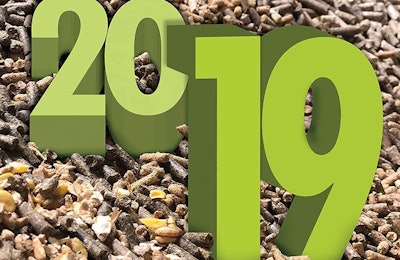
Year-over-year global consumption of animal proteins is growing and, with it, feed production. While the micro trends and challenges influencing livestock production and the related feed industries may vary by region and species, six macro trends should be on the radar of all animal feed industry stakeholders in 2019.
-
Consumer influence the ‘new normal’
As consumers worldwide grow increasingly interested in the food supply chain, their demand for animal proteins produced within specialized systems will continue to grow — trickling down to influence how animal feed is formulated and produced.
“Evolving consumer food preferences and demands are dramatically changing agricultural production, [creating] a ripple effect through the entire agricultural supply chain, including the animal feed industry,” says David Fairfield, senior vice president for feed services at the National Grain and Feed Association (NGFA). “In 2019, animal feed companies will need to consider how to respond to various consumer preference issues.”
Consumers will continue to influence the feed in regard to their attitude toward the use of genetically modified organisms (GMOs), antibiotic-free and no-antibiotics-ever production, the rise of organics, food and feed safety, animal welfare concerns and sustainability.
“This is simply the new normal,” says Dr. Nancy Fischer, a nutritionist with Canadian feed manufacturer Country Junction Feeds, citing the push for transparency, quality assurance and aligning values in animal production. “Society and consumers are having more influence and they have questions and expectations that they want answers to and assurances about. [The feed industry] needs to be prepared to address those questions and expectations.”
In addition, the marketing of animal products is catering to an overall consumer emphasis on “healthy” and “natural” foods.
“Today’s consumers are exploring health through food,” says Raghavan Sampathkuma, the secretariat of India's Compound Livestock Feed Manufacturers Association (CLFMA). “Animal protein must find its place as a healthy protein. To gain this trust, the meat industry needs to raise the bar with food quality and safety.”
Delacon’s CEO Markus Dedl feels feed production can be leveraged to boost the public's perception of animal agriculture.
“The feed industry is the gatekeeper,” Dedl says. “It’s the industry’s responsibility to do its best and use high-quality raw materials, ingredients and feed additives to improve livestock health and welfare. It is a key element in building consumer confidence in the food system.”
-
Antibiotic-free production
The removal of antibiotics from animal production – for growth promotion and for therapeutic use – continues to be a hot topic for animal feed producers and nutritionists.
“In recent years, we have seen more retailers and food producers bend to the pressure of consumer groups by making pledges to go antibiotic free in their meat and poultry products,” says Leah Wilkinson, American Feed Industry Association's (AFIA) vice president of public policy and education. “While these decisions are often purported to protect human health, they have come against recommendations by veterinarians, who view the judicious use of antibiotics as a necessary tool to prevent and control diseases in animals under their care.”
While disease challenges remain the same, producers and nutritionists are taxed to “take a fresh look” at the options and approaches available to make this transition without sacrificing productivity and other important parameters of production, Fischer adds.
To this end, feed additive producers continue to proactively develop antibiotic alternatives, specifically emphasizing gut health and immunity innovations. As new products are developed, the world's feed industry trade associations aim to streamline the regulatory approval process to bring them to market faster.
-
Animal disease threats
The global feed industry is examining its potential role in the transmission of animal diseases, focusing on ways to mitigate contamination risks and improve biosecurity. Though the pains of avian influenza, porcine epidemic diarrhea (PED) virus and other outbreaks are not forgotten, the threat of African swine fever (ASF) is of immediate concern.
AFIA’s Wilkinson notes that while feed and feed ingredients are not traditional disease vectors, if the feed or feed ingredients become contaminated with the virus, studies suggest "some foreign animal diseases can survive on certain feed ingredients during transport."
“As China and Europe continue battling outbreaks of the virus, [US] efforts continue to focus on the methods for preventing ASF and other foreign animal diseases from entering the country,” Wilkinson says.
Novus International’s vice president of products and solutions and chief innovation officer Scott Hine feels feed industry suppliers also need to be vigilant on this front to protect animal production and maintain public trust.
Research concerning how diseases survive in feed and the development of mitigation measures is ongoing.
-
Trade uncertainty
Trade relations will continue to make headlines in 2019 – driven largely by U.S. President Donald Trump’s advocacy of bilateral trade agreements.
“The industry will only continue to grow through exports of feed, pet food products, ingredients and technology,” says Wilkinson. “Although tariffs challenged negotiations with other countries throughout this year, the administration has recently taken several positive steps, particularly the progress made on finalizing the U.S.-Mexico-Canada agreement and signaling its intent to enter into trade discussions with the European Union, United Kingdom and Japan.”
AFIA considers China, Canada and Mexico its “priority countries” for expanding and enhancing U.S. trade relationships.
CLFMA's Sampathkumar reports that despite trade disputes, Asia will remain one of the biggest net importers of grain, noting the region’s fast-growing meat industry, particularly in the aquaculture and poultry segments.
-
Improved animal welfare, sustainability through nutrition
A major element of animal welfare is to protect animals from the damaging effects of stress experienced throughout the life cycle.
“The negative impacts of stress are a welfare issue – but also an economic issue,” Fischer says. “We are learning more as an industry about the hidden costs of stress.”
To address the effects of stress in animal production, the feed industry is making strides in improving animal welfare through nutrition and the use of feed additives.
According to Christos Antipatis, Cargill’s premix and nutrition strategic marketing and technology director, sustainability and welfare in animal production will continue to improve through the combination of nutrition and digital innovations, such as sensors, artificial intelligence, micro-nutrition and other new technologies.
“We are at the dawn of a digital revolution in agriculture,” Antipatis says. "Digital insights will allow the industry to gain precise information about animal health and nutrition, which will allow producers to make better decisions to improve productivity, well-being and sustainability. Such nutritional insights can, for example, reduce greenhouse gas emissions while also improving animal welfare.”
-
Raw material variability, diversification
Raw materials variability due to political and economic tensions will challenge feed manufacturers and nutritionists in 2019, predicts Christophe Bostvironnois, Chr. Hansen’s senior global product manager - poultry.
“A lot of byproducts will be appearing on the market, their nutritional value varying even from batch to batch,” he says. “Managing this variability to keep the animal microbiome stable, and to have consistent and predictable animal production, will be a growing challenge.”
CLFMA’s Sampathkumar feels the feed sector must continue to explore alternative proteins, insect protein, pulse fractions, algae, etc.
This will "require an industry-level push and investments to make these innovations commercially viable products and solutions,” he concludes.
Regulation updates: US and Europe
In the U.S., the implementation of the Food Safety Modernization Act (FSMA) will be high on the feed industry’s radar in 2019 as the FDA begins conducting frequent and intensive preventive controls inspections on feed mills, NGFA's Fairfield reports.
2019 "will be the first year in which all manufacturing facilities, no matter their size, must be in compliance with a portion of the FSMA animal food rule,” Wilkinson adds. “All-sized facilities must be in compliance with the Current Good Manufacturing Practice (CGMP) regulations and could receive inspections. Large and small facilities, meaning any animal food manufacturer who sells more than $2.5 million in animal food sales, must also be in compliance with the hazard analysis and risk-based preventive controls portion of the regulations.”
Fairfield and Wilkinson note the time and resources U.S. feed manufacturers have exerted to comply.
“Next year will be a critical test to see if our industry is measuring up to the Food and Drug Administration’s stringent standards,” she says. “We expect that there will be a learning curve as both the FDA and state inspectors will be trained on how to conduct the inspections and our industry learns what is expected of them.”
In Europe, European Feed Manufacturers' Federation (FEFAC) president Nick Major feels 2019 will be an “abnormal year,” citing upcoming European Parliament elections and a new European Commission.
“From a legislative point of view, there will soon be very little action until late 2019,” he says, also noting that, in the spring, he expects to see the results of the fitness check of EU feed additives legislation.
“For FEFAC, a key element here is the need to lower the barriers for applicants to submit dossiers on generic feed additives,” he says. “If the requirements remain as burdensome as they are now, the feed sector runs the risk of seeing this generic feed additives being lost from the market.”
6 global feed industry trends to watch in 2019
- Consumer influence the ‘new norm’
- Antibiotic-free production
- Animal disease threats
- Trade uncertainty
- Improved animal welfare, sustainability through nutrition
- Raw material variability, diversification
2019 meat production: regional forecasts
Rabobank’s RaboResearch report, “Global Animal Protein Outlook 2019” offers these regional animal protein production forecasts:
- North America: Strong growth in production, with production increases in all species, led by pork; increased exports; and, by percentage growth, beef leads U.S. protein exports.
- Europe: Poultry production is growing, but pork and beef are stable. European exports will grow, and biosecurity will become even more important.
- China: Biosecurity is the top issue for the animal protein sector. Pork production is down, but imports are expected to rise.
- South America: In Brazil, production will grow across all species of the animal protein complex. Local economic conditions influence local demand, but exports will be up.
- Asia: Poultry leads modest production growth in Southeast Asia; however, rising cost pressures will challenge local production and imports.
- Australia & New Zealand: After production declines, limited supplies of beef and sheep meat will maintain strong livestock prices.
Read the full report: https://bit.ly/2qOfr1Z
Feeding poultry to meet evolving consumer demands
The half-day Feed Strategy Conference at IPPE 2019 will examine the role feed plays in building consumer confidence now and into the future. From traceability to successful antibiotic-free production, feed industry stakeholders will not want to miss this forum for knowledge exchange. To register, visit http://www.ippexpo.org/edu_prgms/fsc/
Wednesday, Feb. 13, 2019 • 8 a.m. - noon
Location: IPPE 2019 • Atlanta, Georgia

















